The awesomeness of having more interesting plants in any given space is the basic premise of "phorobana". A phorobana is any potted plant (ie bonsai) that has epiphytes growing on it. For the sake of facilitating communication I took the liberty of creating the word "phorobana" (phorophyte + ikebana). Plus, having a unique word for the idea makes it easier to search for and find relevant material.
It's a basic fact of life that space is always limited. A larger house means a smaller garden. More lawn means less biodiversity. The beauty of phorobanas is that they facilitate biodiversity. They put more treasure on a map.
There's usually quite a bit of treasure at plant shows. However, just like gardens, shows have a limited amount of space. Check out this photo that I took at a plant show...
Is this an Uncarina? If you look closely to the right of it you can see a Dockrillia orchid mounted on a piece of cork. Coincidentally, my friend recently shared a photo of his specimen Dockrillia linguiforme...
As you can see, the orchid is suspended in mid-air. Taking advantage of vertical space frees up horizontal space for more treasure.
The Uncarina has vertical space that could be occupied by the Dockrillia. If the same person already owned both plants, then adorning the Uncarina with the orchid would create room on the map for more treasure. If, on the other hand, the orchid was purchased for this purpose, then more treasure would be added to the map without sacrificing any horizontal space.
The Uncarina and the Dockrillia are both great ideas. Would combining these two great ideas result in an even greater idea?
Peanut butter is a great idea... so is jelly... and so is bread. Most people would agree that the combination of these three ideas is greater than any of these ideas on their own. The whole is greater than the sum of its parts.
With all the different ingredients in the world... the possibilities are endless. This is just as true for phorobanas as it is for dishes. The orchid family alone has more than 20,000 really diverse epiphytic species. Not to mention all the hybrids.
How long will it take to find the phorobana equivalent of a peanut butter and jelly sandwich? It's a numbers game. Finding the lovely outliers in less time depends on more people creating more combinations of epiphytes and potted plants. Progress depends on difference. More difference means more progress.
Right now plant shows are the equivalent of eating peanut butter, jelly and bread separately. These ingredients are good... but they are so much better together! Yes, at ikebana shows there are arrangements that people can "taste". Even though the arrangements can be aesthetically pleasing, they aren't sustainable or informative. But imagine that you are at a phorobana show and you see a Dockrillia happily growing on an Uncarina. If you're familiar with the orchid but unfamiliar with its host, then you can reasonably guess that their requirements are somewhat similar. In this case the association would be informative.
Phorobana shows will be far more informative and interesting than regular plant shows. To help support this conclusion I'll show you some of my epiphytically enhanced potted plants...
Phorobanas should be on everybody's treasure map! Nobody should overlook this valuable idea! The question is... just how valuable is it? Does it matter?
In this video a street vendor is selling artwork by Banksy. The artwork is priced far below market value... but the vendor doesn't inform anybody that it's original art by Banksy. It's the closest thing you'll see to people walking past $100 dollars bills just sitting in the middle of the sidewalk.
Imagine the equivalent scenario with some hunters and gatherers. Of course they are hungry... yet they simply walk past some plants that are loaded with perfectly ripe squash.
In some of the older orchid articles there are accounts of workers in tropical orchards regularly removing the "parasites" growing on the trees. They would rake the precious plants into huge piles and burn them.
Our behavior is far less beneficial when we don't know how valuable things are to other people. In order to maximize beneficial behavior it's necessary to share and learn the value of things.
When we go to a plant show/sale we might find numerous plants that we'd be really happy to have. We can tell a vendor... "I really love that plant!" But usually the vendor doesn't just give it to us. This is because talk is cheap. It doesn't cost us anything to simply say that we really love something. In order to prove that we truly love something, we have to be willing to spend our money on it. If we are willing to pay the price for the plant then the vendor will be happy to give it to us.
Spending our money helps to improve the treasure maps of vendors. The accuracy of their maps determines our benefit! We sure don't benefit if vendors overlook plants that we value. So we use our money to inform vendors which plants are more valuable/needed/wanted/important/relevant. Plant sales give us the immensely wonderful opportunity to superficially ("I love that plant!") and substantially ("I'll buy that plant") participate in the prioritization process. Because everyone is allowed to participate in this process, it makes it far more likely that any given shopper will be as happy as a kid in a candy store.
Perhaps this might seem pretty obvious... yet plant shows don't give everyone the opportunity to substantially participate in the prioritization process. And neither do plant forums! This forum is packed with products but we really don't substantially participate in the prioritization process. Same thing on Flickr... and Youtube... and Netflix. We're allowed to superficially participate in the prioritization process by commenting on and/or rating the different products... but we don't substantially participate. In the absence of substantial participation... the true value of the products is unknown... which means...
1. we overlook valuable products
2. less valuable products are supplied
3. we're less happy in the candy store than we should be
For Netflix the solution is simple. Subscribers should be given the option to earmark their fees to their favorite content. They'd still have complete access to all the content but they'd also have the opportunity to substantially participate in the prioritization process.
A while back on Netflix I watched BBC's documentary "Wild Arabia". In one episode I was quite surprised to see a branch that was covered in epiphytes...
The tree is in the Dhofar mountains in the country of Oman. I really didn't know that Oman has epiphytes! Did you?
Unfortunately, the scene was way too short. I wanted to see and learn so much more about these epiphytes. If Netflix had given me the opportunity to earmark my subscription dollars to specific scenes, then I definitely would have earmarked quite a few to this one. I'm guessing that there wouldn't be too many other people in the same boat as me. But how many subscription dollars would subscribers earmark to shows about plants? I don't know. Neither does Netflix. It's easy enough to find out though.
This system of substantial and specific feedback is applicable to all organizations that have subscribers. But the same system can also work with donors.
When the students in my friend's 4th grade class donate their pennies to their Book Dept, they can use them to help determine the order (relative importance) of their favorite books. When they donate their pennies to their Communication Dept, they can use them to determine the order of their favorite blog entries. This same system could be used for forum threads.
We'd all have the option to donate money to the forum in order to help determine the order of our favorite threads. Not only would our donations support the forum, but they'd also bring the most valuable threads to each other's attention... "Hey! Here's some treasure! Please don't overlook it!"
For all intents and purposes... each member of this forum is in the same tribe! :) We probably don't have to worry about any of our members overlooking squash... but how many new books, articles, blog entries, threads, videos and events are there every day? None of us has the time to read, watch and attend everything. So it's way too easy to miss many valuable things. This is why it's so important to appreciate that our tribe, as a group, can read, watch and attend far more things than any single member of the tribe can. Our tribe, as a group, has far more eyeballs, ears, hands and feet than any single member of the tribe has. Most importantly... our tribe, as a group, has far more brains than any single member of the tribe has. As a group, our tribe can cover far more ground and gather/process far more information than any single member of the tribe can. But in order to realize the incredible potential of our collective body and brain... we need to use our money to improve each other's treasure maps. When each member of our tribe has a far better treasure map, then every single one of us will make far more informed decisions which will improve our treasure maps even more. Our tribe will be the smartest and most powerful and most influential tribe on the internet. We will win the internet. At least until other tribes figure out the secret to our success.
Think about it though... if it's beneficial for each and every member of our tribe to use our money to improve each other's treasure maps... then imagine how beneficial it will be when each and every member of the human race uses their money to improve each other's treasure maps. Then we will be the smartest and most powerful and most influential species in the universe. We will win the universe.
Admittedly, for all I know, some other species has already won the universe. But I do know that phorobanas wonderfully illustrate the idea of a map having more treasure (epiphytic enrichment).
Here's a photo that I took earlier in the year of my very first phorobana...
The Dendrobium x delicatum was blooming.
Does my phorobana look crowded? Well yeah, it's crowded with coolness! This relatively small Moreton Bay Fig (Ficus macrophylla) is carrying way more than its fair share of precious biodiversity. One very tiny passenger is Cleisostoma scolopendrifolium...
Epiphytic enrichment is nicely described in this passage about an aquarium...
The condensed reef's extraordinary hues and alien life forms cast a New Age vibe. To stand in front of this rectangular bottle is to stand on a harmonic node. Here are more varieties of living creatures crammed into a square meter than anywhere else on the planet. Life does not get any denser. The remarkable natural richness of the coral reef has been squeezed further into the hyper-natural richness of a synthetic reef. - Kevin Kelly, Out of Control
Every little corner of the world should be packed with treasure. Every space on every person's map should be packed with treasure. Everybody should be surrounded by valuable opportunities. Everybody should clearly recognize all the valuable opportunities that are available to them. Therefore, everybody should use their money to help each other clearly see all the valuable opportunities.
Ok, so we've covered quite a bit of conceptual ground. Next we can consider some of the practical aspects... such as sources for epiphytes/hosts and matching them.
My favorite sources for epiphytes here in Southern California are Andy's Orchids, Santa Barbara Orchid Estate, Sunset Valley Orchids and Kartuz Greenhouses. Kartuz is also a great source for different potential hosts. Zooming out... by far the single best source for epiphytes/hosts is eBay.
The endlessly fascinating challenge is matching epiphytes and hosts! Logically they should have similar cultural requirements. You probably don't want to attach a Dracula orchid to a Golden Barrel Cactus. Maybe the easiest way to culturally match hosts and epiphytes is to learn which hosts epiphytes naturally grow on in nature.
Here's a photo of a Cabbage tree (Cussonia spicata) in nature with an orchid (Polystachya ottoniana) growing on it...
Here's my Polystachya ottoniana....
Here's Denise's Cussonia spicata...
Her C. spicata is missing a P. ottoniana and my P. ottoniana is missing a C. spicata! Should she give me her Cussonia or should I give her my Polystachya? :D Perhaps the rule is that ornaments are gifted to the owner of the Christmas tree. :)
There are a few relevant cultural details to point out. The bark on a relatively young Cussonia clearly doesn't have nearly as much texture as a mature tree. Also, when the Polystachya grows on the Cussonia in nature, even though they get roughly the same amount of water... I'm guessing that it's a lot more humid there in South Africa than here in Southern California. These two differences (texture, humidity) can be balanced out by giving the orchid some moss and/or more water. If watering frequency is increased then the Cussonia's drainage also needs to be increased (ie more gravel/pumice).
What's rather fascinating about Polystachya ottoniana is its distribution...
This is a map of South Africa. The blue area represents the Mediterranean climate and the black squares represent documented occurrences of Polystachya ottoniana. As far as I know this is the closest that any epiphytic orchid species comes to being Mediterranean. So maybe here in California it might actually take advantage of our winter rain and not be so bothered by somewhat less frequent watering in summer?
It's pretty easy to match hosts and epiphytes based on their natural associations. But you can also match hosts and epiphytes based on their natural habitats. Since California is so dry I'm especially interested in epiphytes that occur in seasonally dry tropical forests. On Flickr I created a gallery of orchids growing on cactus and other succulent plants.
A couple of those photos are of Zelenkoa onusta growing on a cactus in the US Botanic Garden conservatory. How cool is that?! This small orchid naturally grows on cactus in Panama, Colombia, Ecuador and Peru. Not only does it have nice yellow flowers but it also has really neat pseudobulbs...
Another really nice smaller orchid from a drier habitat is Laelia sincorana...
In bright light this orchid will have roundish pseudobulbs and short succulent leaves. I refer to these type of orchids as teapot orchids (short and stout). In its native country of Brazil, Laelia sincorana naturally grows on Vellozia species. Vellozias are so very awesome! Quite a few different epiphytes grow on arborescent Vellozias in nature because their fibrous branches are especially good at holding moisture. It's a real shame that they are so scarce here in Southern California!
Encyclia pyriformis is another of my favorite teapot orchids...
Nature makes the best ornaments! Here are some pictures of potential hosts...
Not sure which plant this is... Dracaena draco or arborea?
Dracaena marginata is fairly common and can be grown from relatively large cuttings. Here's a relevant passage about growing hosts from substantial cuttings...
In completely tropical climates, where the temperature never falls below 55F., the trees could be placed anywhere in the garden or patio. This assumes that severe winds or very dry desert air are not a factor. In such tropical settings, larger trees could also be used. In temperate climates both the trees and the orchids will require a greenhouse or its equivalent. Anyone with a large greenhouse could plant one or more trees directly in the ground. This can be seen, in a well-done fashion, at The Marie Selby Botanical Garden in Sarasota, Florida. There are several good-sized Crescentia trees covered with orchids in their display house. Most people will probably prefer to maintain semi-dwarf trees in large pots. These might be mounted on dollies for mobility, if desired. It may be necessary from time to time to air layer new trees as the old ones become too root-bound and lanky. Probably all of the trees listed will air layer rather easily. Most will also root easily as cuttings under mist. Some, such as Calliandra, Erythrina, Codiaeum, Acnistus, Tabebuia and Crescentia, will root without mist from large cuttings, even up to fence post size. Many of the trees have showy or fragrant flowers, some have attractive edible fruit and several have unusual foliage colors. Any can be grown from seed if it is available and you have the patience. - John Beckner, Host Trees for Cultivated OrchidsHere are some other plants that can be grown from substantial cuttings...
Aloes
Aralias
Bougainvilleas
Cordylines
Cup of Gold
Ficus
Grapes
Moringa
Pachiras
Plumerias
Pomegranate
Yuccas
My friend sent me a photo of this Ficus rubiginosa growing epiphytically...
Most likely this Ficus is going to be chopped off and thrown away. A much better use for it would be for a phorobana. So I told my friend that he should ask the owner for it.
From my perspective, the one group of plants with the greatest phorobana potential are the Aloes...
This is Aloe Hercules (barberae x dichotoma) in a SoCal nursery. I have no idea how this one ended up with so many low branches. But it would be awesome if all the branches were adorned with teapot orchids.
Hercules doesn't usually branch so frequently at a low height. So it doesn't strike me as a particularly good candidate for phorobanas. A cross with far more potential was made by Karen Zimmerman...
This is a cross between Aloe ramosissima and tongaensis. Aloe ramosissima tends to have numerous low branches that are substantial enough for teapot orchids. Unfortunately... it has a few issues. It's a really slow grower, it doesn't grow so easily from cuttings and is fairly prone to rot. Aloe tongaensis is somewhere in between barberae and ramosissima in terms of branch quantity and height. It doesn't have the same issues as ramosissima and might be one of the best Aloe species for phorobanas.
The question is... is Karen's cross even better for phorobanas than tongaensis? I'd sure love to find out.
One Aloe species that is rather interesting is Aloe tenuior. It's a relatively fast grower that produces several upright stems that are around 2-3' tall. It doesn't seem to have an issue with rot. Plus, it grows easily from cuttings and when a stem is beheaded, it will produce one or more new heads. The only real drawback is that the stems aren't substantial enough for teapot orchids.
A few years ago I pollinated my tenuior with pollen from a bunch of different tree Aloes. I didn't keep track of which pollen went into which flower. But now I have four Aloes from the cross. They aren't quite blooming size but I'm pretty sure that at least three of them are hybrids. At first I guessed that they all had the same father but now I'm guessing otherwise.
Here's a photo that I took in November 2015 of one of the largest seedlings next to Aloe tenuior...
At this stage I started suspecting that this seedling and a few others might be hybrids rather than selfings. Six months later I took this photo...
Aloe tenuior is in the back. The seedlings all got taller and heftier... and then slowly flopped over. It was like watching a slow motion trainwreck! Earlier this year I potted three of them up and staked them...
The Aloe on the far right might be a cross between ramosissima and dichotoma. It's substantial enough for teapot orchids but super slow. Aloe tenuior is on the bottom right.
Here's a recent photo...
I should have used taller stakes! The plant on the left is one of my hybrids. It has a stem that is 2x as thick as tenuior's stem. To the right of it is tenuior. On its right is one of my hybrids that has a stem that is 4x as thick. On the far right is my hybrid with a stem that is 3x as thick. The tops of the stems are thicker than the bases. I'm hoping that the bases will thicken with age and then they'll be able to support the weight of the stems. In any case, the tops of the stems can be cut off and potted. Hopefully the headless stems will produce new heads like tenuior does.
The hybrid on the left is by far the slowest. The hybrid in the middle is by far the largest, which is interesting because it was the runt of the litter. It was so small that I didn't even bother including it in the first two photos. The hybrid on the right is by far the fastest.
What's fascinating is that the middle hybrid only has one basal shoot, the hybrid on the right has a gazillion and the hybrid on the left has several. My tenuior produces a few basal shoots. Here are all the potential fathers...
Aloe africana
Aloe arborescens
Aloe dichotoma
Aloe Hercules
Aloe tongaensis
Aloe thraskii
Aloe vaombe
The only potential father that produces numerous basal shoots is arborescens. I've read, and heard, that it tends to be dominant in its hybrids. None of my hybrids resemble arborescens. Honestly I was somewhat surprised that any of the fathers were compatible with tenuior. They are superficially quite different. Aloe tenuior and similar species have recently been moved into their own genus... Aloiampelos. So all my crosses are intergeneric.
The other day I gave my friend Fernando cuttings of my two most prolific tenuior hybrids. It was the first time that I've shared cuttings. The offshoots are only now getting large enough to share. It's interesting to participate in the very first dissemination of a new plant. So far the hybrid with the least offshoots is spreading slower than the hybrids with more offshoots. I'm guessing that this will continue to be the case. It stands to reason that the shareability of a plant will significantly influence its proliferation. Here in Southern California, Aloe arborescens is a contender for the most common Aloe. It's probably not a coincidence that it produces abundant offshoots that can be easily cut and rooted. Aloe vera might be more common and it does produce offshoots, but they have to be dug up. Its prevalence is most likely the result of its medicinal properties.
I'm not sure how long it will take my hybrids to reach blooming size. I'd definitely like to see their flowers... but I'm far more curious to see their mature form. How much phorobana potential will they have? There's always room for improvement. It would be really cool to try and cross my hybrids with Karen's hybrids.
Hopefully more people will hybridize Aloes with the goal of creating varieties that make awesome phorobanas. Kinda like people trying to build better birdhouses.
I'd sure love to see lots of Aloe phorobanas! Wouldn't you? Or would you love to see other things? In all cases it's unfortunate when we overlook valuable things. This is why it's so important for us to easily improve each other's treasure maps.

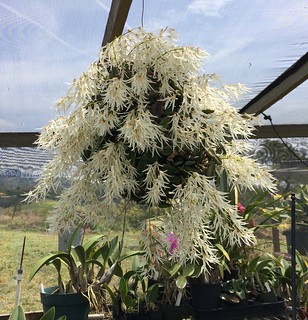


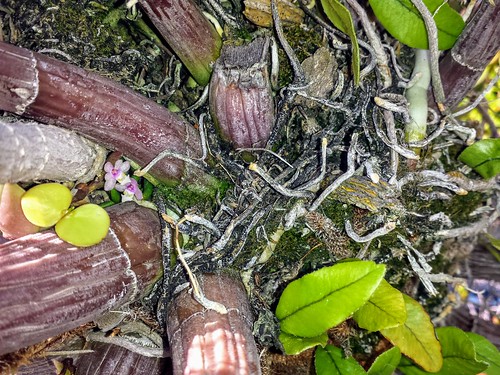



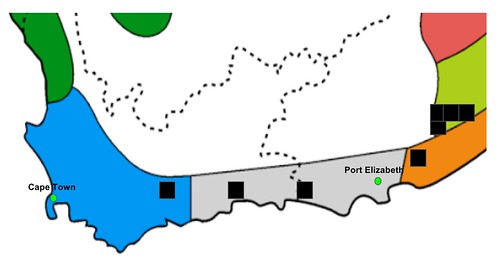
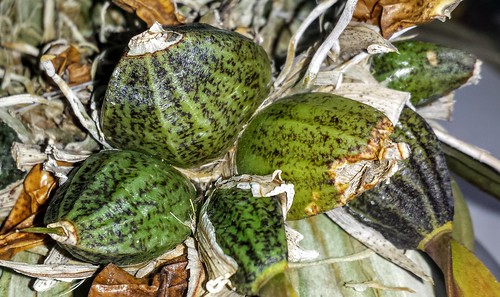

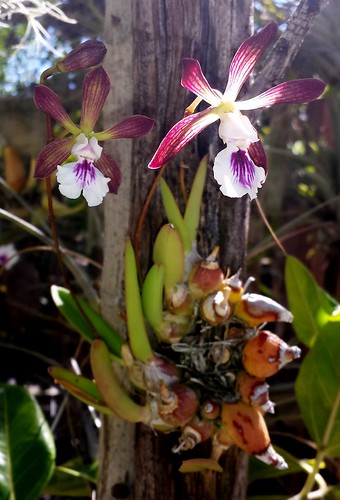









Carlos, this was a very interesting read, full of take-away treasures -- thank you so much!
ReplyDeleteGlad you appreciated it! Thanks for letting me use your photo. :)
DeleteThis is awesome! It would be great for plant societies to disseminate your information to their members. So many people complain of limited space(myself included), and phorobana would be the answer to all our problems. It is just a really complete way to bring two great ideas together.
ReplyDeleteThe video was perfectly informative, clear, and well executed.
Thanks! I look forward to seeing which plant you choose to host Scadoxus nutans. Also, don't forget to propagate Acnistus arborescens!
Delete